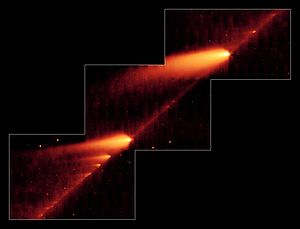73P / Schwassmann security guard 3
| 73P / Schwassmann security guard 3 [i] | |
|---|---|

|
|
| Properties of the orbit ( animation ) | |
| Orbit type | short-term |
| Numerical eccentricity | 0.692 |
| Perihelion | 0.943 AU |
| Aphelion | 5.184 AU |
| Major semi-axis | 3.063 AU |
| Sidereal period | 5.36 a |
| Inclination of the orbit plane | 11.4 ° |
| Perihelion | October 16, 2011 |
| Orbital velocity in the perihelion | 39.9 km / s |
| history | |
| Explorer | F. Schwassmann , A. Wachmann |
| Date of discovery | May 2, 1930 |
| Older name | 1930 VI, 1979 VIII, 1990 VIII, 1930d, 1979g, 1989d1, 1994w |
| Source: Unless otherwise stated, the data comes from JPL Small-Body Database Browser . Please also note the note on comet articles . | |
73P / Schwassmann-Wachmann 3 , also known as SW3 for short, is a short- period comet . It is best known because between 2001 and 2006 the breaking of its core into numerous fragments could be observed.
discovery
The comet was discovered on May 2, 1930 by the two astronomers Friedrich Karl Arnold Schwassmann and Arthur Arno Wachmann at the Hamburg observatory . He approached on May 31, 1930 to 0,062 on AE to the earth and reached an apparent magnitude of about 6 mag. This comet is the third short period comet found by Schwassmann and Wachmann.
history
Despite its orbital period of just over five years, the comet remained unobserved for a long time after 1930. Observations are only available from its return in 1979 and 1990, but the comet was not very conspicuous. In 1995, the comet surprised astronomers with a sharp, unexpected increase in its brightness from around 13 mag to around 7 mag (250 times the brightness) within a few days. The reason for this was that the comet's nucleus broke into several pieces, apparently releasing large amounts of gas and dust. First three, then a total of five parts of the comet could be observed, which were designated with the code numbers A to E. At the next return at the turn of the year 2000/2001 only three fragments (B, C and E) could be found again.

The next time the comet returned in the spring of 2006, the comet parts broke apart again, which became noticeable to observers on Earth in increasing brightness. When it came closest to Earth on May 13, 2006 with 0.074 AU, the two largest fragments (B and C) reached a brightness of around 5 mag. In particular, the shape of fragment B changed several times in early May 2006, resulting in strong outbursts of brightness. In mid-May 2006 over 60 fragments, some of them extremely faint, were known.
The Hubble Space Telescope and the Spitzer Space Telescope took spectacular pictures of the breaking comet. The events were also followed with earth-based telescopes, including the Very Large Telescope of the European Southern Observatory . Even amateur astronomers were able to observe the breakup of the comet very well with highly sensitive CCD cameras .
73P / Schwassmann-Wachmann 3 was originally the target of the US CONTOUR mission , which was to reach the comet on June 18, 2006 and approach it at a distance of only around 100 kilometers. However, the space probe crashed shortly after its launch in 2002.
Especially since its crumbling, but also before because of its temporary weakness of light, the comet is unofficially called "weak man" in astronomical circles.
Near its last perihelion to date, it reached a brightness of 12 mag on February 10, 2017. Previously, he could be observed again on February 13, 2016 at the Lowell Observatory in Flagstaff.
Meteor shower
73P / Schwassmann-Wachmann 3 is the original body of the Tau Herculids , a meteor shower that is active from May 19th to June 19th.
Expected return
The expected return is calculated for 2022. (there: orbit period: 5.36 years, last perihelion: June 2006, Oct. 2011, Feb. 2017).
See also
Web links
- Gary Kronk's Cometography of Comet Schwassmann-Wachmann 3 (English)
- Images from the Hubble Space Telescope (English)
- Images from the Spitzer Space Telescope ( Memento from May 14, 2007 in the Internet Archive )
- Images from the Very Large Telescope (English)
- Photos by amateur astronomers
- Info page with numerous links (German)
Individual evidence
- ^ Christian Overhaus: observation tip in May 2006 . Sternfreunde-borken.de. Retrieved June 27, 2010.
- ↑ http://www.space.com/scienceastronomy/060510_comet_spitzer.html